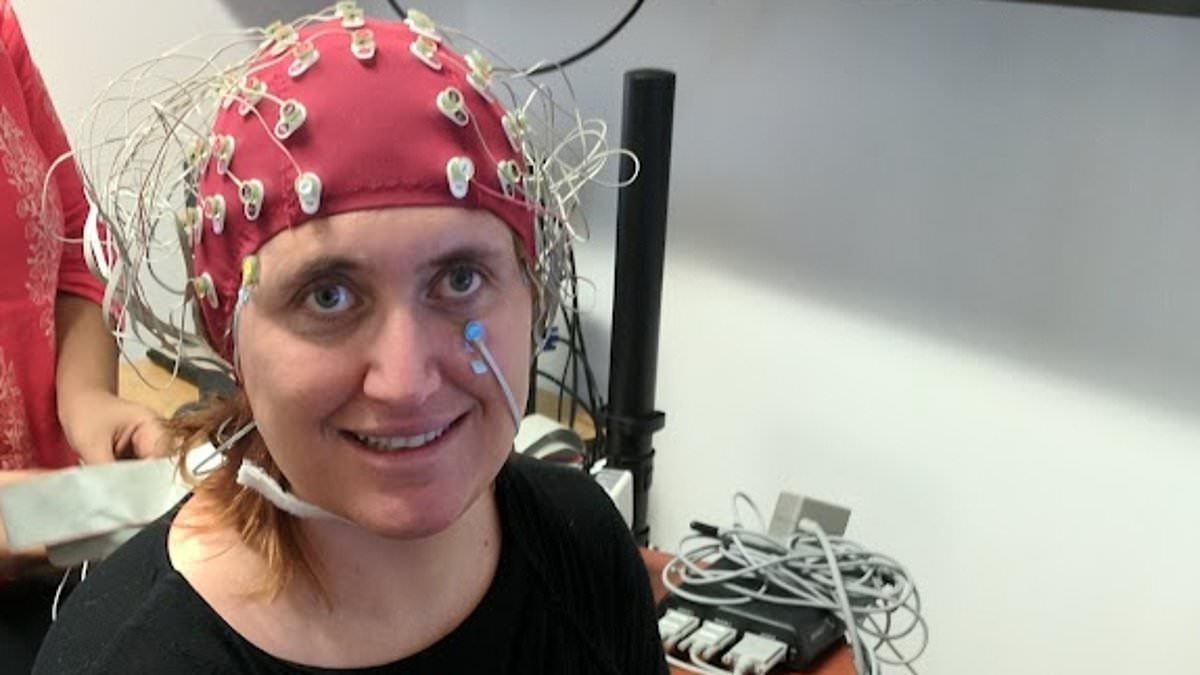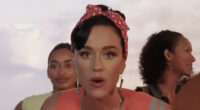Sadie Dingfelder was in the grocery store when she first realized her occasional difficulty recognizing people was more a problem than a quirk.
Trailing behind her husband Steve through the aisles of a Safeway, she noticed he picked up a jar of store-brand peanut butter from the shelf, to which she asked, ‘Since when do you buy generic?’
In answer, the man she thought was Steve jumped, his face contorted in a mixture of confusion and horror. It was not her husband.
Blaming the embarrassing mix-up on the fact that Steve and the stranger were wearing the same coat, she had a disturbing thought bubble up from her subconscious on the ride home: Other people do not make this kind of mistake.
The incident set off a years-long domino effect of efforts to understand why she had such trouble recognizing faces, even those of her family and closest friends.
It all culminated in a diagnosis of the neurological condition face blindness in 2019.

Sadie Dingfelder has undergone numerous tests across the country to diagnose her face blindness and she participates in research studies and trials

The best way a non-faceblind person can imagine how those with the condition see faces, Ms Dingfelder said, is to look at a celebrity’s face upside down
Ms Dingfelder, a journalist based in West Virginia, documented the lengthy investigation in a new memoir, Do I Know You? A Faceblind Reporter’s Journey into the Science of Sight, Memory, and Imagination.
In her book, she writes: ‘I’ve always known that I’m a little quirky, but for forty-odd years I didn’t realize I was having trouble with tasks that other people find trivially easy. From where I sit, if you’re like 98 percent of the population, you’re a face-recognition virtuoso.’
Face blindness, also known as prosopagnosia, is a neurological condition that renders a person incapable of recognizing faces, including one’s own.
About one-in-33 Americans – three percent – may meet the criteria for face blindness, equating to about 10million people, according to a Harvard University study.
Typically, the brain takes a holistic approach to analyzing faces, integrating individual features like the length of the nose and the shapes of the eyes into a cohesive whole.
We recognize faces thanks to the fusiform face area (FFA), a part of the brain located behind the ears in the temporal lobe, a major region in the brain that helps people use their senses to comprehend the world around them.
It is involved in things like interpreting sounds, recognizing and using language, encoding memories, processing emotions and object and music recognition.
The FFA is automatically activated when someone looks at a face. It gathers data from seeing individual features – the left eye, the right eye, each eyebrow, the cheeks, freckles, mouth, nose, and more – and combines them into a three-dimensional shape.
That image is then compared with stored memories people have of faces. Then, with the help of other brain regions, the FFA matches the perceived face with one the brain already knows.
This allows a person to recognize a face from different angles, in varying settings and under different lighting.

The journalist’s concerns grew when she mistook a stranger in the grocery store for her husband

Multiple tests and brain scans done as part of a Harvard University study revealed Ms Dingfelder was severely faceblind
But someone who is face blind ‘can’t do any of those things,’ Ms Dingfelder wrote, and faces all look the same to people with the condition.
‘I lack some of that specialized face-recognition software,’ she added, comparing the brain to an advanced computer system.
The best way a non-faceblind person can imagine how those with the condition see faces, Ms Dingfelder said, is to look at a celebrity’s face upside down.
She wrote: ‘The features will remain perfectly sharp, but they probably won’t hang together for you like they did before. You may even find a celebrity who you can easily identify right side up becomes unrecognizable when flipped upside down.’
In severe cases of face blindness, people have trouble recognizing loved ones who they live or interact with on a regular basis. They may even have trouble recognizing themselves.
People with face blindness also have a hard time following TV shows or movies because they cannot keep track of the characters.
Ms Dingfelder wrote: ‘So, while you may forget someone’s name from time to time, I bet you have no trouble following movies, even if the main character puts on a hat, or — worst of all — gets a makeover.
‘Me watching Pretty Woman: “Who’s that? What happened to the prostitute?”‘
Some faceblind people are predisposed at birth to the condition and it was gradually develop over time, while others have it because of an injury or brain lesion.
People with the condition often rely on non-facial information to identify a person, such as hair color, smell, gait, voice or clothing.
Ms Dingfelder often uses hair as an identifier, writing that she tells the difference between two of her friends named Ann by their hair color: ‘Red Ann and Brown Anne.’
The FFA develops as a person’s brain matures. The area starts out very thick as a child and should thin out as a person ages, strengthening the FFA’s recognition ability.

People with face blindness often rely on non-facial information to identify a person, such as hair color, smell, gait, voice or clothing

Ms Dingfelder wrote on Instagram: ‘I’ve decided to, as an experiment, maybe just for a little while, wear these stickers and shirts I made for myself and stop faking it all the time’
Ms Dingfelder writes: ‘Children start out with thick FFAs, but as the brain determines which neurons are useful and which ones are just getting in the way, it thins out the useless ones, creates more connections among the useful ones, and adds insulation to improve the connection speed.
‘This so-called neural pruning and myelinization seems to have stopped short in my brain, at least in this one area.’
During childhood, Ms Dingfelder was often buried in books rather than playing with friends because her inability to recognize people made classmates think she was standoffish and disinterested in meeting new people.
And she spent most of her life greeting everyone with a smile, not wanting to unknowingly snub a friend or coworker.
It wasn’t until 2010 that she learned about face blindness when she came across a story about it. She recognized some similarities between the author and herself, but didn’t think much of it until fall 2018.
After the grocery store incident and a similar occurrence in a Baltimore art museum, Ms Dingfelder put her facial recognition skills to the test in the Cambridge Face Memory Test.
Part of the test asks viewers to look at a face for 20 seconds and then pick that face out of a line up among two others at different angles or slightly blurred.
The average score is about 80 percent. Ms Dingfelder scored 58.
Based on her results, she was invited to participate in a face blindness study at Harvard University led by Dr Joseph DeGutis, one of several scientists she would come to meet and interview to get to the bottom of her neurological diagnoses.
After undergoing more tests and brain scans, Dr DeGutis told her: ‘Your ability to learn new faces is among the worst of our prosopagnosiacs. You were one of the lowest scores that we’ve registered so far.’

Ms Dingfelder is a journalist based in West Virginia
He added her FFA was thicker than average, more like that of a 12-year-old, and her facial recognition ability was akin to that of a ‘below average macaque.’
Ms Dingfelder wrote: ‘Wow. I’m not just below average, I’m the worst of the worst!’
While she met the news with humor at first, she was soon ‘hit with a tsunami’ of emotions
She wrote: ‘But then the numbness slowly starts receding, and I’m hit with a tsunami of conflicting emotions: sadness, relief, confusion, enlightenment, jealousy, vindication… I’m simultaneously having a full-on meltdown. Tears and snot are streaming down my face.’
As her journey into her neurodivergence continued, Ms Dingfelder discovered she had multiple other neurological conditions, including stereoblindness, aphantasia and severely deficient autobiographical memory (SDAM).
When a person is stereoblind, they do not see in 3-D. Instead, the world is flat because there is a disconnect between where the eyes want to focus and where the eyes can look together.
Ms Dingfelder likens it to looking at a painting.
While at the eye doctor one day, she wasn’t able to pick out the images in a vision test that appeared in 3-D.
She wrote: ‘He explained that while most people combine their two fields of vision into a single image, I switch back and forth between my left eye and my right eye. As a result, my depth perception sucks. Three decades of missed Frisbees and spilled drinks suddenly made a lot more sense.’

As her journey into her neurodivergence continued, Ms Dingfelder discovered she multiple other neurological conditions, including stereoblindnes
As many as 20 percent of the population may not be able to fully see in 3-D, with a large portion unaware of the issue.
Stereoblindness makes it hard to walk, catch objects and drive, with Ms Dingfelder only recently getting behind the wheel.
She described her terror while learning to drive on empty West Virginia roads alongside her husband, having difficulty driving in a straight line.
She said road markings would converge on the horizon to form an optical illusion that made her think cars were rushing right towards her.
For another study that looked at the ability of virtual reality headsets to train a stereoblind person to see in 3-D, a scientist measured Ms Dingfelder’s stereoacuity, or the ability of the visual system to perceive depth and objects in three dimensions based on binocular vision.
She said: ‘On average, adults have a stereoacuity of 45 arc seconds – and with that level of 3D vision, you can detect fractions of centimeters at close range. You must have a stereoacuity of less than 25 to be an Air Force pilot. Anything over 80 is generally considered impaired.
‘Want to guess my stereoacuity? Name a number. Go higher. Higher still. Now quadruple that. You got it: 3,207 arc seconds.’
The virtual reality experiment required her to wear the headset and play a series of games that involve aiming, shooting and jumping from landmass to landmass, all in the hopes of improving her depth perception and training her brain to see in 3-D.
It worked — somewhat. She began performing better on the stereoacuity tests, though she did not reach the average score. She was even able to enjoy a 3-D movie for the first time.
But there was yet another shoe about to drop.
Ms Dingfelder first heard of aphantasia in 2015 when she read a medical case report on it, but it wasn’t until a conversation with a distraught friend going through a breakup that she seriously considered she had the condition as well.
Her friend was able to describe a vivid scene in her mind of running into her ex-boyfriend in public. She described the café and where in town it’s located, the afternoon light streaming in through its windows, what he was wearing, and how he smelled.
Mrs Dingfelder said: ‘The specificity, the sensory details – if I had that kind of an imagination, I’d never leave the house!’
When comparing herself to her friend, she realized she couldn’t mentally visualize anything at all.

Ms Dingfelder wrote a book on living life with prosopagnosia, a condition also known as face blindness

Ms Dingfelder (right) also has aphantasia and severely deficient autobiographical memory (SDAM)
She said: ‘That means all sorts of things that I thought were just figures of speech — daydreaming, imaginary friends, undressing someone with your eyes, counting sheep — are much more real than I realized. Why didn’t anyone tell me?
‘Now that I think about it, there were clues. I’ve been instructed, for instance, to deal with stage fright by imagining the audience naked.
‘I thought I was doing it by thinking about how the audience could be naked. Meanwhile, my fellow musicians were gazing upon rows of bare torsos, and who knows what else.’
When a person is told to think of a cat, they will conjure up an image of a four-legged furry feline, based on what they know a cat looks like, but people with aphantasia are met with empty minds and a blank space where their imagination should have filled in an image.
About one-third of people with aphantasia suffer from poor autobiographical memory – difficulty remembering details of your own life. Additionally, about one-third of people with aphantasia also have face blindness.
Ms Dingfelder is what sociologists call neurodivergent. The term originates from the neurodiversity movement that picked up in the 1990s, which pushed for greater acceptance of neurological differences as natural variations in the human population.
Some other examples of neurodivergence include autism spectrum disorder, dyslexia, and Tourette syndrome.
There are no cures for her conditions, but there are exercises Ms Dingfelder can do to improve the way she sees the world, such as the training she has done with virtural reality for her stereoblindness or perceptual training for her face blindness.
Perceptual training teaches people with the condition to look for and remember facial features and help identify people by specific features.









